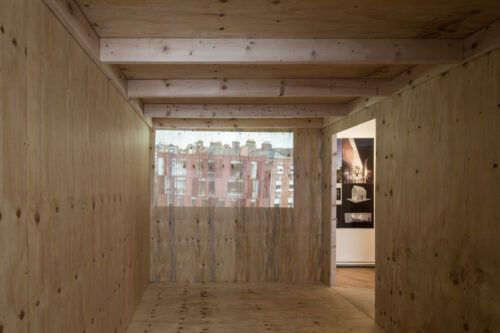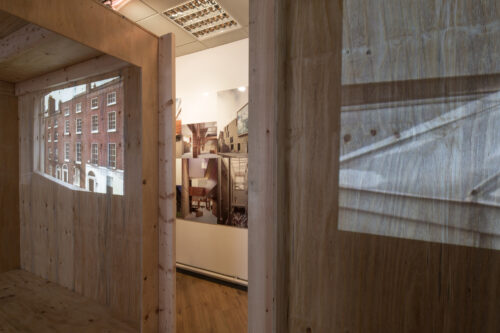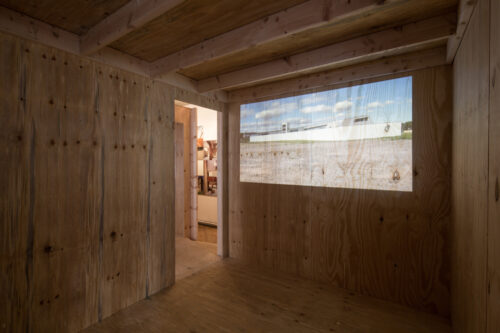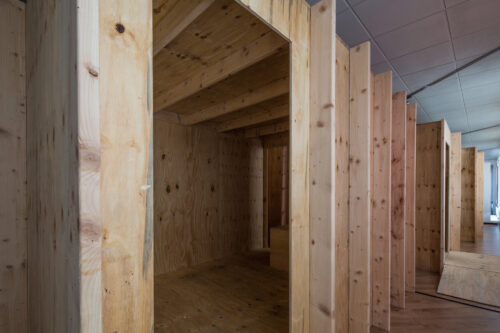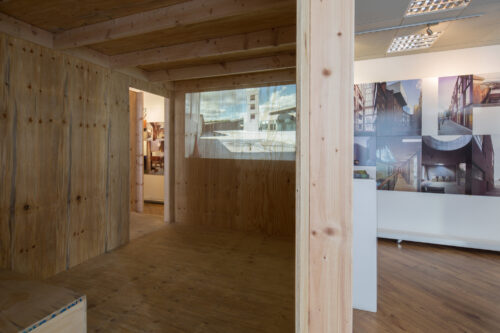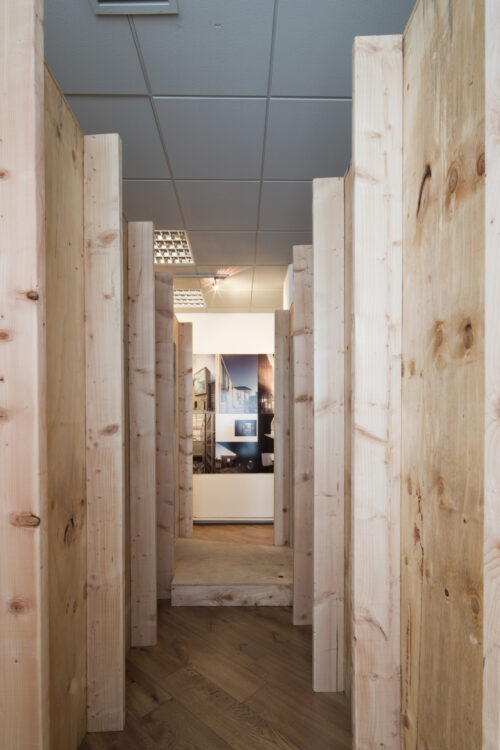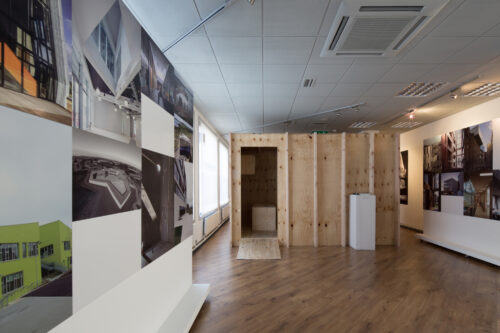The Cervantes Institute in Dublin, located in Lincoln Place, is holding an exhibition of the work of McCullough Mulvin Architects. Running until 25 September 2015, the show is being held to coincide with the publication of a double issue of the Valencia-based architectural monograph series, TC Cuadernos, that documents the work of the practice. While some of the exhibition takes the form of wall-mounted panels, the focus is on three specially constructed plywood screening-rooms, within each of which a film is projected. These three films correspond to the tripartite thematic organisation of McCullough Mulvin Architects' work in the publication – 'Dublin' (which includes projects such as the Ussher Library [2003] and the Long Room HUB [2010] in Trinity College); 'Interventions (Recovering the Past)' (The Model Arts & Niland Gallery [2000], Rush Library [2009], etc.); and 'The Roofs in the Landscape' (the still-under-construction Waterford Fire Station and the Beaufort Maritime and Energy Research Building, etc.)
In approaching the significant and far-ranging work shown in the exhibition and publication – the beautifully produced large-format TC Cuadernos double issue, which runs to 526 pages, is itself an immense achievement – it is necessary at the outset to stress the range of Niall McCullough and Valerie Mulvin's work as cultural producers. The exhibition displays the buildings, but these emerge in relation an important body of writing and reflection, which stretches from the architects' 1989 book A Lost Tradition: The Nature of Architecture in Ireland, through Niall McCullough's 2007 Dublin, An Urban History: The Plan of the City and his 2014 Palimpsest: Intervention and Change in Irish Architecture. There are many architects who write about their work, but strikingly few whose writing displays the kind of scholarly appetite, expansiveness and inquiry that we see with McCullough and Mulvin. Here the writing is in an open, interlocutory relationship with the design work: it is a way of exploring interests and concerns that, while linked to design, are never instrumentally determined by it. The familiarity of the architects in the Irish context can obscure just how unusual and important this achievement and attitude is – it is certainly interesting to pose the question of how many comparable cases can we think of, anywhere, practicing today?
McCullough Mulvin Architects might well be taken to be contextualists, and it is something that they themselves would acknowledge and have written about. But at the same time their work poses important questions about what we mean by that term. Contextualism is often taken to be based upon a purely mimetic relation, such that the building conforms to those around it by resembling them in scale, form and material. However, one immediately wants to point out how radically impoverished such an idea is. For example, the discursive and intellectual milieu within which architects work is no less important a part of the context of their projects than is the physical condition of the sites to which those projects are addressed. What is particularly impressive here is the breadth and pertinence of the ideational context that McCullough Mulvin have actively constructed for themselves. Certainly their projects are 'local', in the sense of being highly attuned to the places in which they are constructed (a locator map of the Dublin projects on the tenth page of the TC Cuadernos monograph is a remarkable diagram that indicates the extent of the architects' contribution to their native city); but equally, at the same time they reflectively participate in, and significantly add to, a mobile international discourse of architectural ideas – of which the very notion of contextualism is itself part. The status of the work as both place-based and international is certainly reflected in the fact that it has been an invitation from a Spanish publisher that has led both to the monograph and to this exhibition in Dublin.
Moreover, the work of McCullough Mulvin Architects indicates to us the possibilities of a different and more critical kind of contextualism – one that is less concerned with imitating what exists, than with setting things in relation to it, so that we see it better or even in a transformed way. Here the relation is non-mimetic, but no less grounded in contextual considerations for that. Instead, it becomes a case of placing things in such a way so as to activate subtle patterns of difference, gentle alternations whose effect is to bring to the surface what has hitherto gone unrecognised. It seems to me that a very particular quality of the work of McCullough Mulvin Architects derives from something like this: our encounter with the projects is an encounter with the way that they constellate form around themselves. Attention does not settle on an individuated architectural object, but is instead rerouted through the new complex of relations that has emerged. The experience of the 'building' is always the experience of the 'building ... and ... and ... and ...'.
This ethos is articulated in the three films showing in the Cervantes Institute, especially in the way they appear – at first encounter – almost subjectless. Contrary to normal expectations, there is no central architectural protagonist, no obvious point of attachment in the image whose importance is decided in advance for the viewer. The films certainly show us something, but do so in a way that demands less passivity and more patience from the exhibition visitor. These are trenchantly non-didactic pieces, which do not instruct us what to watch but instead hold out fields of vision (and sound) for us to explore. Often in the films McCullough Mulvin Architects' projects occupy oblique and eccentric positions, existing as peripheral presences within the almost-motionless moving images. The position of the camera is always fixed: it never pans, and any movement derives from incidental and contingent occurrences – a gust of wind, a car in a street, an office worker wheeling out a bin into a backyard. In the films we might feel narrative begin to flicker but, importantly, it never develops. Instead, they seem to show durations in which the flow of events in time has receded to almost nothing and we find ourselves occupying a sort of interval between tenses, one that shimmers with latency and imminence.
- Mark Dorrian

